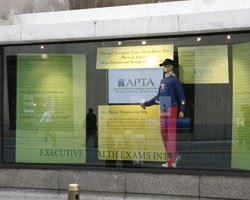Or, I could have entitled this blog post:
I went to school for a lot of years, got a doctorate degree, learned your anatomy inside and out and for that, I can tell you "Go out and play an hour a day."
It just seemed a little wordy.
These were the words of Rear Admiral Penelope Slade Royall, PT, MSW, as part of her keynote address Wednesday night at PT 2007, the annual conference of the APTA. The headline of the speech was her "telling the considerable crowd that physical therapists are public health’s "first responders" for fitness." Royall is the US Deputy Assistant Secretary for Health in the US Department of Health and Human Services.
Well, is EVERY American our patient? Is physical fitness our specialty? Will Physical Therapists speaking as one voice about physical activity guidelines really help our profession and our patients? I’m not so sure.
Or, is the ideal set forth by the Evidence in Motion working group, "that to improve our caliber as a profession, we have to shrink our role and be identified as experts in neuromusculoskeletal medicine" one that will help our profession and our patients?
Reading headlines such as "PTs: First Responders to Physical Fitness" seems to me to be suggesting our role to Americans is really one of a personal trainer. Personal trainers do physical fitness better than Physical Therapists. Perhaps this is because they specialize in it.
This goes back to an old question of strategy: Should one try to do everything well, or should one do just a few things expertly?
You know, thinking more about the contents of the keynote address, I really feel like Royall is speaking about Physical Therapists in a light that will further her own agenda (and here) rather than our profession’s agenda. I would do the same in her position; so would most. If a government representative like Royall views Physical Therapists as Physical Fitness Responders, then what are we really?
This post is more questions than answers. This is deliberate, as I think a public debate about how PT’s are marketing their profession is required. We should all spend some time asking ourselves some questions about this issue.
Labels: APTA, physical therapy, PT Publicity Project
 How bad is bed rest for your back?
How bad is bed rest for your back?




